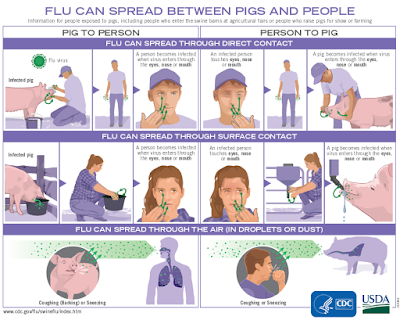#13,446
Five days ago we learned that San Luis Obispo Public Health Were Investigating Suspected Swine Variant Flu Cases linked to recent attendance of the California Mid-State fair. This announcement came just a week after a similar report out of Michigan (DOH: 2 People Test Positive For Influenza After Contact With Infected Swine).
North American swine flu viruses are typically H3N2, H1N1, or H1N2 - although other variants have occasionally been reported (see 2015's J. Virol: Novel Reassortant Human-like H3N2 & H3N1 Influenza A Viruses In Pigs.)
When they jump from pigs to humans, they are dubbed swine variant viruses and acquire a `v' suffix .We are still awaiting details (including subtype) on the Michigan cases (perhaps from today's CDC FluView Report), but late yesterday afternoon (California time) the San Luis Obispo County Health Department published the following update l.
Update: Two SLO County Influenza Cases Confirmed as Influenza A (H1N2v)(Continue . . . )
Author: Public Health Department
Date: 8/3/2018 6:18:23 PM
The patients have recovered after a brief illness. The risk to the public is very low.
Update, August 9:
The Public Health Department, in collaboration with the California Department of Public Health and the Centers for Disease Control and Prevention, has confirmed that two cases of influenza in San Luis Obispo County are variant influenza A (H1N2v) infections. The patients had brief illnesses and have recovered.
Influenza A (H1N2) is a type of influenza that spreads among pigs. Influenza viruses that spread among pigs are occasionally transmitted to people who have close contact with pigs. When this happens, the infections in humans are called variant influenza virus infections. Variant influenza virus infections are usually mild, with symptoms similar to those of seasonal influenza. However, like seasonal influenza, serious illness is possible.
The patients in this case all had extended contact with pigs at the California Mid-State Fair, where a pig infected with influenza A (H1N2) was present. Mid-State Fair officials have fully cooperated with the Public Health Department and supported this investigation.
In recent years, variant influenza virus infections have occurred each summer in the United States, and most infections have been linked to exposure to pigs at agricultural events.
When the virus is transmitted from a pig to a person, it generally does not spread widely to other people.
It cannot be transmitted by eating pork.
The fair ended on July 29, and no new cases from contact with pigs at the fair are expected. Additional influenza tests conducted by the Public Health Department as part of this investigation have been negative. While additional cases associated with the situation might be identified, the risk to the general public is very low.
The Public Health Department continues to investigate this situation. Keep reading for the original article, with FAQs on this type of influenza.
All swine variant flu infections in humans are considered rare, but H1N2v infections have been the least commonly reported subtype (roughly 3% of cases), although we've seen a noticeable uptick over the past several years.
Assuming the Michigan cases are confirmed, and adding these two cases from California, there will have been 472 swine variant cases reported in the United States since 2005.Most of those cases were reported during the summer and fall of 2012 when a 10 state outbreak caused more than 300 infections (see graph below).
 |
| Credit CDC FluView |
Still, it is important to limit the opportunities for pigs to infect humans (and vice-versa). Earlier this week the CDC released a new infographic on preventing the spread of these viruses.
 |
| https://www.cdc.gov/flu/pdf/swineflu/transmission-between-pigs-people.pdf |
